|

ON-LINE NEWSLETTER
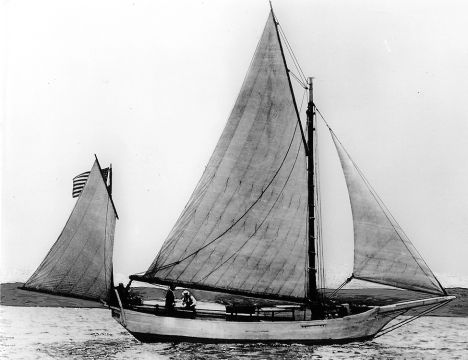
|
This rare photograph shows SPRAY off Sydney with
Joshua Slocum and Sydney business man Mark Foy. They are trying
out the new set of sails that Foy had presented to Slocum. Photo
courtesy Dr Kenneth E Slack.
|
What is a SPRAY ?
READ THE TRUE FACTS ABOUT THE SPRAY !
Please read below and you will learn all about this
wonderful design. I hasten to add that the original Spray is the real
hero in this story and as you learn more about this series hopefully
you will join me in your admiration of the basic Spray concept. Here are
a few assorted Spray photos to get you started.
In 1892 at the age of 51, Joshua Slocum was given a
decrepit sloop called Spray. and spent the next two years
rebuilding this vessel. He removed the centreboard and replaced nearly
every piece of timber in the hull, deck and superstructure. He sought to
improve the seaworthiness by adding some freeboard, so that the boat
would be better suited to the deep water sailing he obviously had in
mind.
All the materials used in the reconstruction were
collected around Fairhaven, in Massachusetts, where Spray had
lain in a field for several years. The boat’s lineage is clear when one
examines photographs of early examples of the North Sea fishing boats
that have worked off the coasts of several countries bordering that
area; and rumour has it that the Spray was over one hundred years
old when she was given to Joshua Slocum. There was a story that she had
worked as an oyster dragger off the New England coast. Joshua Slocum, a
seaman with vast experience, must have recognised something of the
potential of his new acquisition, for otherwise he would not have
invested two years of his life in the total rebuilding of her. As it
turned out, he could not have made a better choice.
At time of writing there are over 4,000 SPRAY's sailing the
oceans of the World and hundreds more currently being built in almost
every country; a great tribute to a great boat.
These pages will be used to
disseminate information about the Spray and generally inform those
interested in this wonderful boat and her successors. To all members of
the Slocum Spray Society and others interested in the Spray...please
email me with your comments, questions and suggestions for this on-line
newsletter. There is considerable information including photographs and
text, in these pages so please feel free to either down-load or print
out whatever interests you.
8 - 1
What do critics
say?
A spray? Huh - they're slow....”.
A typical comment from people usually
who have never been on a Spray. NOT true ... read the many
owners reports of cruising speeds of 8 to 11 knots depending on wind and
sea conditions
.... And so what? Being a cruising vessel
and many used as live-a-boards it’s not likely they will be out in every
race-weekend to do battle for a few more points towards some trophy.
PLEASE
... Read Joshua Slocum's
book "SAILING ALONE
AROUND THE WORLD" ...
I have just now (2017) re-read my battered copy and found it as
refreshing as when I first read it in 1970 !!!
What do the owners
say ? Please read on !!
Below you can read the experiences of just a few of the
many thousands of sailors who have cruised the worlds oceans in their own
Spray ...
|
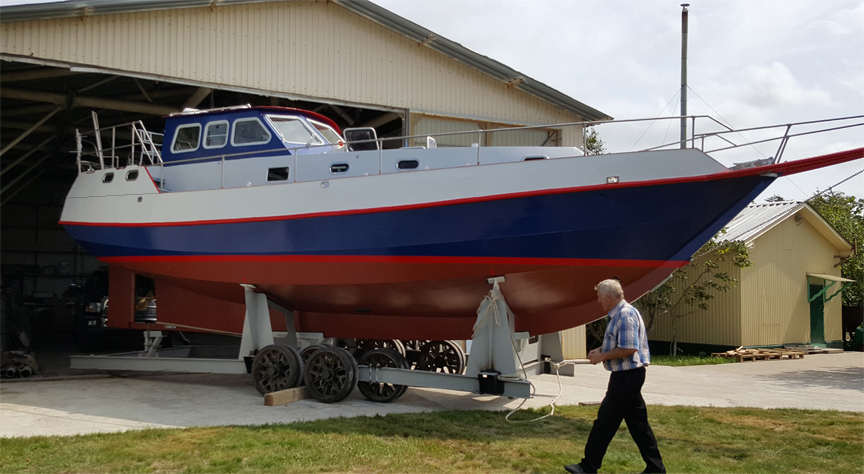 |
SPRAY 370D
This Spray 370 was
built from Bruce Roberts cutting files and plans by Igor in
Russia.
This is the second Spray that Igor has built - the first
one was a Spray 22
Igor and his family loved the boat so
decided to build the larger Spray 370 pictured here.
The complete "STEP BY STEP" STEEL OR ALUMINUM PLANS & CUTTING FILES assembly photos
are included with the
Spray 370 STUDY PLANS.370"'
SEE MORE SPRAY' 370s |
|
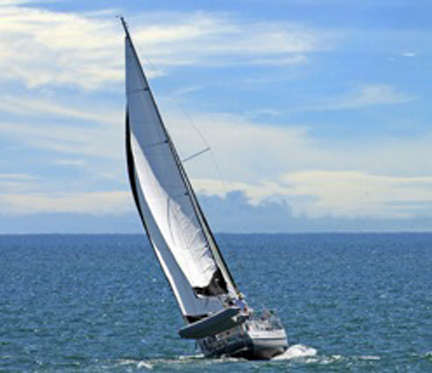
|
I am attaching one of my favorite underway
photos of SILVERADO. In the past two years I have experienced
virtually all sailing conditions one will see in the Sea of
Cortez. |
|
SPRAY 28
Aluminum version built by Robert Millikin
Hi Bruce, I had a very successful launch on Nov 7th in
San Carlos, Mexico. Many photos of the launch. Feel free to use any
photos for your CD e-book BUILD YOUR OWN SAILBOAT. I have taken the boat
out a dozen times since the launch and am very happy with its
performance. It does well on all points of sail and really loves
15-20kts! I am very happy with the results of my years of labor
and am very appreciative of your timely responses to all my questions
over the years. Thanks, Robert Millikin
TWO YEARS LATER:
It's been two years since we launched SILVERADO. We have
logged around 2500 miles in the sea of Cortez....The
boat is amazing! I am attaching one of my favorite underway photos
of SILVERADO. In the past two years I have experienced virtually all
sailing conditions one will see in the Sea of Cortez.
The boat is extremely
comfortable in all conditions especially when it gets rough. Thanks again for your timely responses. Robert
Millikin Tucson, AZ
SEE MORE PHOTOS OF THIS & OTHER SPRAY 28'S |
|
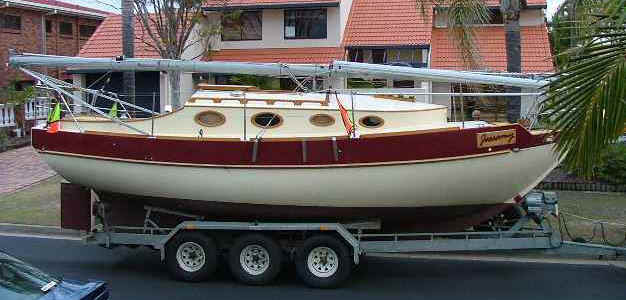 |
Spray 27
Version A (Standard Coach House)
This Spray 27 was built in Germany where many
Sprays of all sizes have been built over the past many years. |
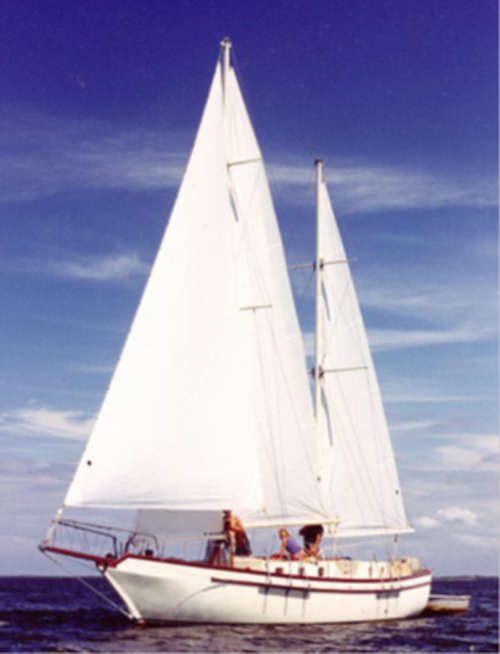
Charlie Jupp's Spray 40
![s40a-05[1].jpg (8914 bytes)](public/HTML/images/s40a-05[1].jpg)
'Peggotty' This Spray 40 was built by New Zealand engineer
Alan Sendall who reports that his Spray cruised at 8 knots despite the ill
fitting second hand sails he originally fitted to his Spray
SEE SPRAY 40
SPRAY 40
Email from Rick Ganly.
As this correspondence refers to one of the the
first-ever of the Roberts Sprays I feel that is is appropriate that it heads up our SPRAY
Newsletter.
"I sailed on the first 'Spray' you designed built by Charlie Jupp across
the Pacific years ago. What was an awful trip spending 70 days to reach Brisbane
from the Cook Islands. A cyclone done its best to pull the boat apart and loosing the
rudder back-sliding down waves didn't help. Still, Spray did get us to land safely
a
great achievement in anyone’s estimation". Best regards Rick Ganly.
|
SPRAY 40
Charlie Jupp built
the first fiberglass Spray 40 from a hull molded at the Bruce Roberts Marine
Park in Brisbane Australia. Charlie sailed from Brisbane, Australia &soon
after we received the first of several letters: Charlie sailed his Spray to
England and and back to Australia mostly single handed as he preferred it
that way !
‘I left Brisbane for Mauritius, a voyage of 4500
miles and about
2000 miles off the Australian coast
I had trouble with my appendix. I lay in my bunk for five days with all sail
up, with a rising wind; Spray
steered herself. When the pain eased, I sailed for Mauritius, and on arrival
I let the anchor go. The yachties saw I was in trouble, and came and took
the sail off. I had an operation, but felt very weak so I stayed another two
weeks, then sailed for Durban. Lousy trip, last two days were storms and
lightning. Had a glow at the masthead, rigging was very hot. I went below; I
thought the boat was on fire. As I was coming down the coast, a
helicopter flew very close and took photos of the Spray, and last night she
was on TV here.
I will be leaving here at the end of December. Most
yachts are taking on extra crew as far as Cape Town; they think I am mad,
but if I can’t get a good crew, I’m better off on my own.
I had no worry
about my Spray in the storm. It blew 50-60 knots, gusting to 70. I will let
you know how things go around the Cape. Charlie Jupp’s second letter came
from St Helena:
‘Thanks for your letter and all the help I received
in South Africa. I am in St Helena there is no harbour, so it’s a big job
getting ashore. I met a lot of people building boats in South Africa, and over a hundred people came to see
me off at Cape Town. My Spray sails very well, I sleep ten hours, and she
stays on course all night. I hope to sail tomorrow; I will let you know how
things go.
‘I have just arrived in Falmouth after leaving the
Virgin Islands. I was 40 days crossing;
I had calms, head winds, fog and storms. People who
draw upwind charts should try sailing with them. They show west wind; I went
looking for it and I nearly saw polar bears I was that far north. As I came
up the Channel the weather was perfect, not a cloud in the sky; it was warm
seas, flat and a full moon. What more could I ask?
When I left South America for Barbados, I was 300
miles from Barbados when a foreign fishing boat with 12 crew came alongside
and forced me up into the wind. Two crew came over the side ready to drop on
to my deck, when a freak wave threw us apart. The skipper pulled a revolver
and fired. I got one in the leg, and a few in the deck, so I shot at the two
crew and got one in the skipper’s arm. He got on the radio to his mate, but
a naval patrol picked up his message, came and fired across his bows, and
gave me an escort for the day. So for a week after, every time I heard a
noise at night I would go on deck, with rifle in hand.
While in the Virgin Islands I did have an offer to
skipper one of the charter yachts, but I’d made up my mind I wanted to go to
England first. The Spray stood up very well in all weather.
I carried sail,
when in other yachts I would have reefed down, so over a long distance I am
not behind other yachts, sometimes I would be a day before them.
‘I got a letter from a yacht club meeting in London
to ask if I would go along and give a talk on my trip, and also, my easy
method of navigation. Everything was to be laid on, food, drink and pay, but
I had to decline the offer as I had very few photos and material to talk on,
and so many people are sailing round the world and writing books nowadays. I
have decided to keep the Spray, and you may see me on the west coast of the
States this coming year.
I have sailed and delivered a few
yachts for owners, and so far I haven’t sailed on a yacht as comfortable as
the Spray,
if ever I built another, it would be on the same lines.
On the River Hamble
here there are over 3000 yachts, but there’s very few I’d swap my Spray for.
Charlie reckoned he could put a cup of coffee on
his cabin table in a 30 knot wind, and it would stand without movement.
Like the original, this Spray will sail herself,
although rigged as a Bermudan ketch she will hold a steady course for days
on end unattended. In a storm the boat looks after herself better than the
helmsman can with a storm jib to hold her steady. With a good trade wind
blowing, Charlie set two jibs boomed out, with main and mizzen, and lashed
the wheel, and left the ship to her own devices.
Also like the original vessel, Charlie has two
separate cabins, with no cockpit; his wheel is amidships, sheltered by a
canvas windscreen, and protected by ample bulwarks.’ There is none of this
sitting up in the cold and wet on this boat,’ says Charlie. ‘As soon as it
gets dark, I go to bed. I sleep ten hours every night and wait for the sun
to come up before I get out of my bunk.’
Charlie sailed like this across the Indian Ocean in
some 4,500 miles from Australia to Mauritius, with the ship holding her own
course. He did not touch the helm until he was in sight of the harbour,
being tied to his bunk sojourn by the attack of appendicitis.
Charlie Jupp enjoyed no special advantages over
anyone else in making his dreams come true. Twenty-seven years ago he was
working as a labourer building sea walls in Essex when he made the decision
to emigrate, choosing Australia because of the sun. His subsequent efforts
at sugar cane farming convinced him there was no profit in small crop
husbandry, so he got a job as a builders’ labourer. After three years, he
was building houses himself, which he did for a decade or more until the
credit squeeze forced him to lower his selling prices.
C harlie
arrived safely back in Brisbane after transiting the Panama Canal and
sailing on into the Pacific.
With about
2,000 miles still to go, Charlie had lost the use of his rudder. Crevice
corrosion in the stainless steel rudder shaft had caused the rudder to
become inoperable. He managed to sail the boat for some weeks without a
rudder, and steered the Spray quite
successfully until he reached port.
MORE INFO SPRAY 40 |
|

Spray 33 - At anchor
in the Pacific. |
SPRAY 33
Southerly
Buster
One
of the most travelled Spray 33s ever built
This Spray 33 was built at Ballina NSW Australia by John
Page. This boat was completed in the very creditable building time of
under 8 months.
This must be
one of the most travelled Spray 33s ever built; John has
successfully completed many single handed ocean voyages in
Southerly Buster cruising to New Guinea, the Solomon Islands, and Thailand by way of
Christmas Islands, the Philippines and Indonesia.
The most notable
voyage, a complete circumnavigation, was undertaken with Carol
Larkin as crew. Countries visited included, South Africa, Brazil,
various Caribbean Islands, Panama, and back to Australia calling at
Brisbane, before completing the voyage at Darwin Northern Territory
Australia.
The worst weather encountered was 200 miles off Townsville,
Queensland, when Southerly Buster
rode out Cyclone
Ivor. John found himself 40 miles from the
centre of the storm and considered himself lucky the avoid the worst of a
very serious cyclone;
he only experienced 80 knots, at the centre it was
reliably reported that the wind speed reached well over 100 knots.
John reported his best passage was Cocos Keeling islands to
Rodrigues a distance of 2000 M [5179 km] covered in 13 days. During this
crossing the crew slept every night with winds of 25 to 35 knots on the
quarter.
SEE MORE
SPRAY 33's |
|
SPRAY 36 A
EMAIL FROM
Luiz Carlos S. Silva
"Did you know that the first
Brazilian sailor to complete the globe circumnavigation single handed did it
in a Roberts 36 Sailboat ?
His name is
Aleixo Belov in 1982 . The
boat was the "Tres
Marias" built for himself.
He completed two more
circumnavigation of the world
with the same boat."
SPRAY 36 - Fiberglass - Sept 2017
Hello, I built a fiberglass 36 Spray and launched in
'92. What a great boat she has Been
! I originally bought a running rigging STEEL OR ALUMINUM PLANS & CUTTING FILES from you. Thanks, Chris
Beidler, Florida, USA
|
SPRAY 38
S/V Emerald Steel San Diego, Ca.
Dear Bruce,
This email is 29 years
overdue.
In 1985 we
purchased your blueprints for the 38' steel spray and the next year and a half we spent all our time building her in
San Diego, Ca. At that time I , Jules, was 35 and my wife,
Suzie, was 22. My wife learned how to weld for the project and
so she did all of the welding. I did all of the cutting,
grinding and general encouragement.
The next 20 years we sailed between 45 south and 55 north in the Pacific
ocean.
She has been our full time home ever since. She is very comfortable
and a safe cruiser during the gales and storms of high latitudes.
We even
went unharmed during Hurricane Iniki in Hawaii 1992. We would like to thank
you for the fine design for which we have received many compliments over the
years. Picture included.
We recently posted 3 clips of her on U-TUBE called
The voyage of Emerald Steel. You might be
interested in viewing them. Thank You again, Julius and Suzie Hanak
S/V Emerald Steel San Diego, Ca. U.S.A
SEE MORE SPRAY 38
Including videos of building & sailing "Emerald Steel" |
|
COMMENTS FROM
SPRAY 33 OWNER ABOUT "BLACK PEARL"
Our boat has cruised to Spain, Portugal and the
Mediterranean, and has made two Biscay crossings in severe weather.
We
have nothing but admiration for her sea keeping qualities and we have
never for one moment felt unsafe in her and she returned good passage
times in strong winds. |
Centennial SPRAY 45
Dear Bruce,
I can tell you
my own impression of sailing the Centennial Spray 45. I
made a trip cross the Baltic sea. She steering herself
really, just need to carefully put sails on right
position.
I did not touch the steering wheel for more
than 20 minutes, just look at compass.
Excellent
performance, just nice.
Thank you very much for smart
design. Best
Regards, Victor V. Tchaburko |
|
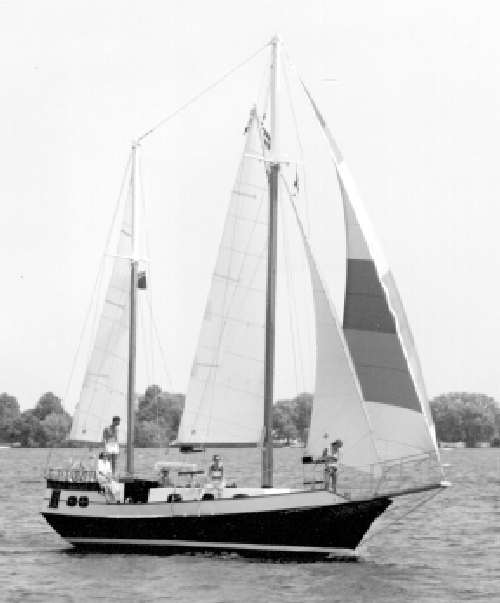
SALTY SPRAY
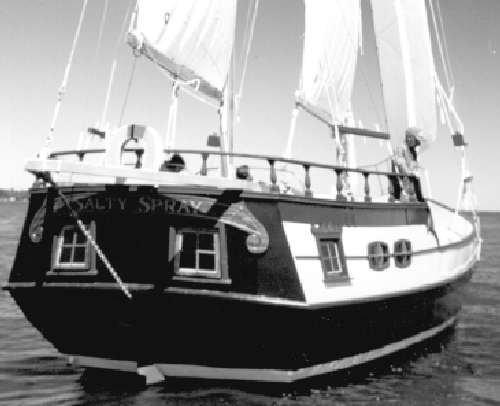
SALTY SPRAY
|
SPRAY 40
-
"SALTY SPRAY"
Howie Franklin writes:
‘On 14 August, we were out sailing on Lake Simcoe, which
is just north of Toronto. It was a warm and pleasant day, but I was concerned
about the possibility of thunderstorms. About 1630 and on our way home, the sky
darkened and it was obvious we were going to be hit by a storm. Since there was
little wind, I had decided to sail on jib-staysail and mizzen. The main was down
and stowed. Soon the rain became heavy, and visibility was down to 50ft [15.25m]
Things were still OK, until all of a sudden the wind
velocity increased from 10 knots to
about 80 knots in less than 15 seconds, and
Salty Spray was knocked
down. The storm was part thunderstorm, part tornado, and we didn’t have the time
to release sheets. It all happened so quickly
I am telling you this story because I want you and
your customers to know of the incredible integrity of the Spray. In our
knockdown, I think the masthead touched the sea, and yet she rolled back up with
no damage done, except to the captain’s pride.
She had water inboard, but that was later discovered to
have come from the freshwater tank, had siphoned up through the galley tap. It
was an unfortunate incident, which could have been much more serious if not for
the incredible integrity of the Spray design; I had 12 souls on board that day,
and we all went out again the next the faith we all have (even stronger now) in
the design of Salty
Spray.
Although it frightened us at the time, the incident did
not deter us from proceeding with our plans for the future with the Spray. I
just wanted you to know how proud we are of our boat.
Howie is a former airline captain so is used to dealing with crisis
situations. Some years ago he sailed
Salty Spray from Canada
down the east coast of the USA to Florida,
and we lost
track of him for some time. However in December 1993 we received
another letter that read as follows; well, Salty
Spray
is still going and he is in very good shape at
this time. We are still enjoying the boat, Further correspondence with Howie
produced the following comments:
‘What I can do is tell you of all the good
things we like about
Salty Spray,
starting with that nasty double knockdown we had and her survival was a fine
display of her great integral stability. Since then we have had many good times,
including a trip down the Mississippi river to New Orleans, then over to Florida
where she now resides at Key Largo. What I like about the Spray is that most
other people like her too. Spray seems to be like a story book dreamboat, yet
here she is for real.
She is a great live-a-board and when we get
together with friends with their boats, someone always says, ‘Bring your boat;
we need the poop deck for dancing.’ She is certainly comfortable, stable,
likeable and a lot of fun.
SEE SPRAY 40
|
|
SPRAY 33
in Kemer / Turkey
We spent two full
seasons cruising the Med and in September 2000 departed
Portugal for the Cape Verde Islands via the Canary
Islands. December the 1st found us leaving Mindelo/Cabo
Verde and bound for Barbados.
We still didn't have any
self steering fitted, but then again neither did Slocum.
No problem. Blue-Belle took 16 days to make the 2037
mile crossing, that's an average of 127 miles per day.
Her best days run being 147 miles.
For a heavily laden
cruising boat with a 28 ft water line she could
certainly turn in a decent passage time. We were
delighted with her.
We also found that running downwind
she didn't roll as much as other boats I'd sailed under
similar conditions. Regards Derek. |
Spray 40 A
Steel or Fiberglass
Hi Bruce, we just sold (a bitter-sweet moment) our Bruce
Roberts designed Spray 40 in a slightly modified Spray 42' (LOD) that was
built by a South-African German naval engineer O.L. Silvester in the mid
70s and launched in 1984 (see picture attached).
Heritage was
built using the C-Flex method, and I must say, even in tough weather, we
never so much as experienced a shudder from her; we absolutely love the design, especially the
hull shape, and very stable sailing properties, but sold her mainly
because we are looking to up-size to accommodate a family of 4.
SEE SPRAY
40
|
|
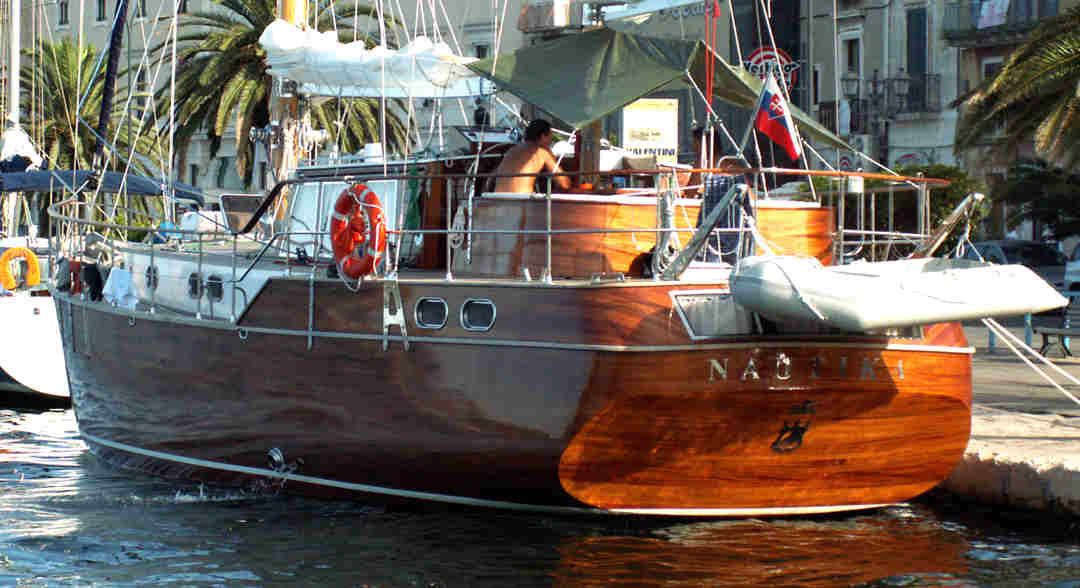
 |
Centennial SPRAY 45
SEE MORE Centennial SRAY 45's
Dear Sirs, We purchased your project of Centennial Spray 45
and my friend - Zihni Butuner,
built the beautiful Melissa1 in his factory - Tire Profil in Izmir Turkey.
(attached some photos). l
She was finished and launced in 2007 and since then she is sailing in the Eagean and he is very happy with her. She is now in Teos Marina - Turkey. Thank you, Gideon Tur
|
|
SPRAY 40
Hi Bruce,
My
wife, Pat knew that I needed to be on the water and found a
Spray 40
built in Vancouver, BC. She convinced me to spend the
extra revenue that I received from working too many hours on the
Gitane Des Mers (47’ LOA. 40’ LOD, 14’6” beam). When
friends ask how I convinced my wife to let me buy the boat, I
simply reply, I broke down and let my first mate talk me in to
buying the boat. I realize the bad humor, yet it applies.
J
Although I am still learning the boat, our Spray 40 performs
well, we have a Volvo 6 cylinder diesel that we use for marina
ingress-egress and have found that even the sloop configuration
sails well (although I still prefer the junk schooner rig).
We averaged 6.5 knots for a few hours and 7.2 knots for about a
half hour until I reduced sail to enter our protected winter
moorage.
The Spray is everything that I had read and
heard from other owners. Although we will not win races,
it is a heavy smooth sailing and comfortable sailboat—exactly
what we want. Regards Gene
|
SPRAY 33
Pretty good shape for a 25 year
old + steel boat. I knocked some paint off the hull
when I had her pulled. The hull was flame zinc’d when
it was built. There’s no rust what so ever, anywhere.
Even the hollow rudder is sound and tight….. rather
impressed. The yard at South Park has filled up
fast, so I’m not sure where they’re going to put me for the
winter and until spring when I can repaint her…….. but I’ll
be able to re-do the interior in the mean time.
The
Miller 140 welder with Argon fits well into the cabin, and
I’ve been welding foundations for the Nav station, and
better storage. The Marina is alive with stray current and
the zincs were on their last leg, after two years in the
water, they were fried. Am going to install two
systems into the hull, and re-do the zinc anodes.
Mike
Dooley
|
|
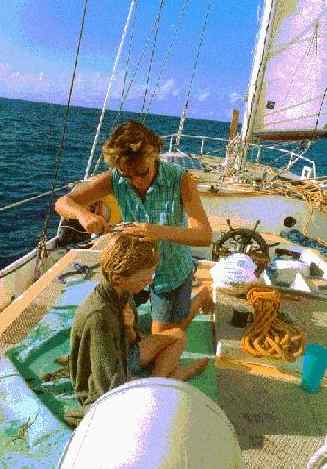 |
SPRAY 40
"JUMBLY GIRL"
We all know that the Spray design is
a stable and forgiving platform. While we may arrive later than the others we enjoy a more
comfortable ride, with the capacity to carry more luxuries. I have just brought
Jumbly Girl home solo (cutter-ketch Spray 40 C) from Florida to Falmouth.
A quiet and comfortable passage without drama. Now to get ready for
another trip.
Nic.
"Jumbly Girl"
LEFT: Photo of "Haircut in the Old Bahama
Channel" , on passage from east end of Cuba up to the Carolinas. Note, empty cockpit, windvane doing the work, bread rising in the plastic bag. Just another day at sea.
|
|
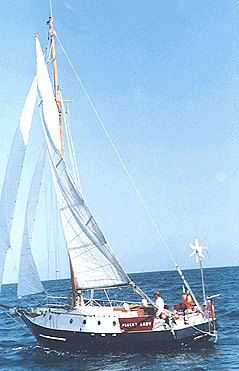 |
SPRAY 33
Plucky Lady"
-
Gaff
Cutter
EMAIL
FROM OWNER:
Here we are on our way from the Cabo Verde Isl. To Guadeloupe.
"Plucky Lady" is a Spray 33 - steel version. She's custom built and was launched
in 95. She's a very fine, seaworthy and comfortable boat. We are very happy with her. Best
regards L.D. France
STUDY
PLAN PACKAGES ON DOWNLOAD or on USB
. . .
GIVE ACCESS TO HUNDREDS OF step by step BOAT & STEEL OR ALUMINUM PLANS & CUTTING FILES ASSEMBLY
PHOTOS ...
See
details |
|
1.
Centennial SPRAY 45
We ordered preliminary boat plans for the Spray from
Bruce and started adapting our layout to the 45 foot
hull.
When Bruce released his round bilge version, the
we were convinced this was the perfect hull for us. The
hull characteristics were a major for our layout without
compromising the sailing characteristics.
We sent our
deck and cabin layout to Bruce and contracted with him
to do a set of drawings using them.
|
2.
A
wonderful thing happened when working with Bruce;
we had originally drawn the deck with a doghouse over
the companionway. He, faithfully, had a doghouse in the
drawings that he did for us. He sent this
alternate design to us as a gift.
We so much like the idea
of the open pilothouse creating a bright open space out
of the saloon and galley that we adopted it. We were
able to take the general concept and implement it in the
final design. Regards Ben Smith ...
NOTE: Ben Smith uses his boat to
run successful charters.=
|
|
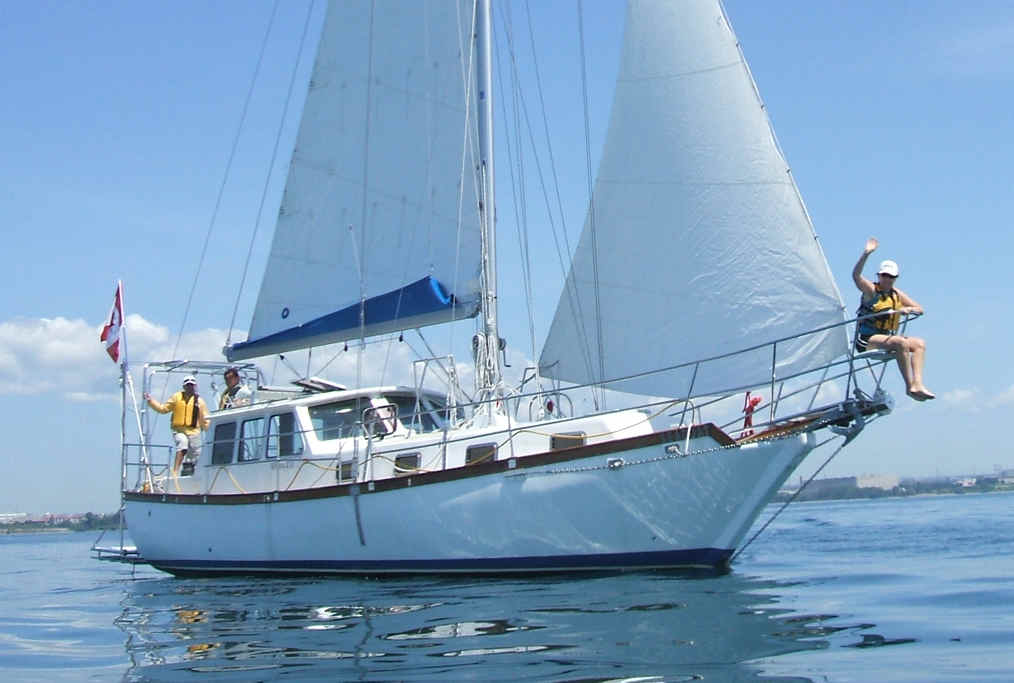
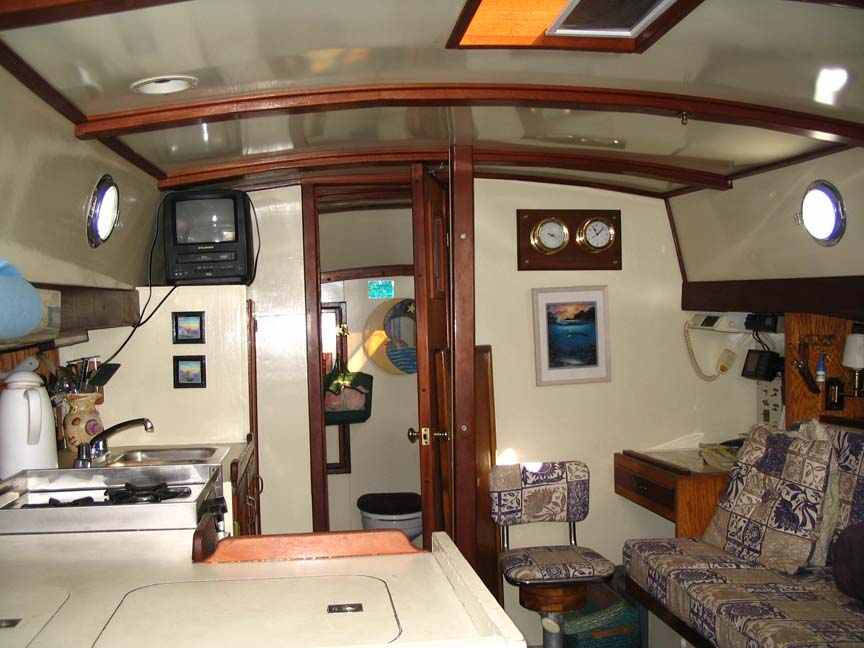
Step by step
construction photographs of this
boat
are included in S36 STUDY PLAN PACKAGE. |
SPRAY 36
Pilot House fiberglass version.
SEE MORE ON
THE SPRAY 36
Bruce, Thank you for your quick reply.
I built " Tequila Mockingbird " in my backyard in
Denver, Colorado USA. over a 10 year period. We trucked the boat to San
Carlos, Mexico in 2007 and launched her. We've been living aboard full time
since then. I chose the pilothouse version and have been very happy with the
choice. We've been through 2 hurricanes and have never been worried about
the boat handling any conditions we've encountered.
I've attached a couple of pictures, the first was
taken as Tequila Mockingbird being craned out of the back yard , the start
of it's trip to Mexico. The other picture was taken in Agua Verde which is
on the Baja Penisula here in Mexico. Thanks again for the zinc info' Ed
Kennedy
HI BRUCE,
Thanks for getting Edgar in
Holland to help me with the rudder hydraulic cylinder sizing, he was very
efficient and logical. The 48hp turbo-diesel Bukh is mounted and aligned
along with the prop shaft. All four stainless steel tanks have been
installed, diesel, water, black and grey water.
I've had the majority of
the interior framework welded in, including all five door frames. I am
installing a 5kw Mastervolt generator right behind the pilot station. You
can't beat these Dutch when it comes to making things for boats! I have
configured both a forward and a stern head along with passage way doors to
pass through the engineroom back to the stern berth. I'll send you some
interior
shots so you can see what that looks like. Thanks for all you help and
advice. Kind Regards, Dave
SEE MORE ON
THE SPRAY 36 |
|
FROM SPRAY 370
BUILDER:
Subject: Re: Spray 370 A
... I have finished cutting my STEEL OR ALUMINUM PLANS & CUTTING FILES using your cutting
files; I would like to thank you for the time & effort
you put into the nesting. I thought it would be good but
I am amazed at the ease with which the machine just
chugged along and the result with all the alignment
marks and part numbers etched on, brilliant!
The
file modifications for the aft cabin roof and the
etching for the walk thru all appeared on the plate. It
really is good to deal with professional people. The
construction of the hull is going smoothly. I cannot say
how pleased I am with the result of your cutting files !
Thanks and
Regards Bill Wigan Dubai .
SEE SPRAY 370
|
SPRAY 33
Derek & Hulya S/Y Blue-Belle Park
We
find the Spray to be a wonderful sea boat, and is a lot
faster than she looks. When running in gale force
conditions we find that our heavy weather staysail,
sheeted flat amidships (a technique used by Slocum in
his book) works well.
The bow showing NO tendency to dig
in despite all the weight we carry up forward. One
mistake we made in the early years was in reefing her
down too early; the boat is very stiff and sails well in
heavy weather. In storm conditions when it is more
prudent to stop and we either heave to or lie to a
parachute anchor streamed from the bow and attached to a
bridle led back to a cockpit winch. In this manner we
feel safe and secure.
So, would we
part with our Spray? Would we change her for something
else? No - not ever. After 8 years and 35.000 miles we
finally have our ultimate cruiser.
Thanks Bruce, you gave us a great boat.
Kindest regards,
Derek & Hulya S/Y Blue-Belle Park Kemer Marina
Kemer Antalya/Turkey
|
|
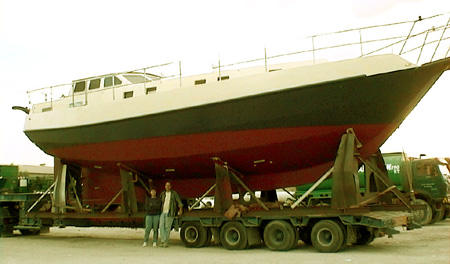 |
SPRAY 460 A
SEE MORE ABOUT THE SPRAY 460 Spray 460
assembled from one of our STEEL OR ALUMINUM PLANS & CUTTING FILES
by Mike and Pam Ford in Dubai.
NOTE'
We now have an excellent set of
construction photos plus many photos of completed Sprays that are available
with the STUDY PLAN PACKAGES. |
|
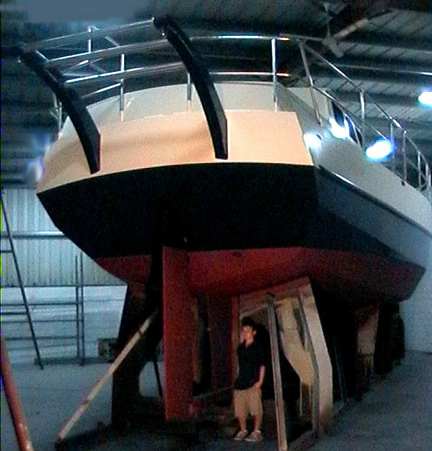 |
SPRAY 460 A Spray 460
assembled from one of our STEEL OR ALUMINUM PLANS & CUTTING FILES by Mike and Pam Ford in Dubai.
Recent email for Spray 460 builder in RUSSIA.
Bruce HELLO! I finished the
assembly of the boat! I worked from January 2 to February 20, 5 days a week,
3 people. Your project is excellent! No errors! Photos can be seen
https://www.facebook.com/yachtadelta
All Russian sailors looked for the
building!
Thank you for your project. Andrey
SEE MORE ABOUT THE SPRAY 460 |
|
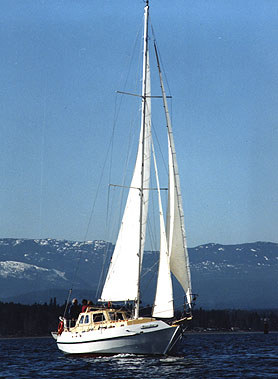 |
"Brass Loon"
was built in Canada by Leuder L.
Kerr.
Spray 340 pilot house version is
modelled on this custom version of the Spray 33
SEE MORE
SPRAY 340 |
|
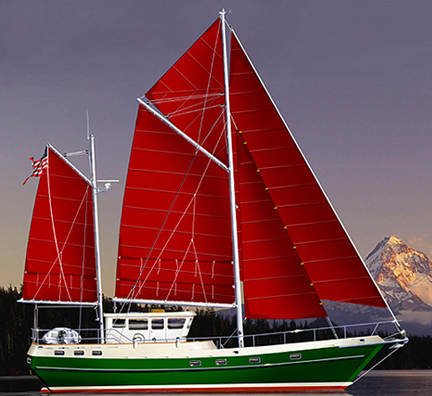 |
Spray 52 / 58 Trawler/ Trader
Sailing version a variety of rigs can be used on the versatile design.
SEE MORE SPRAY 52
/ 58
|
|
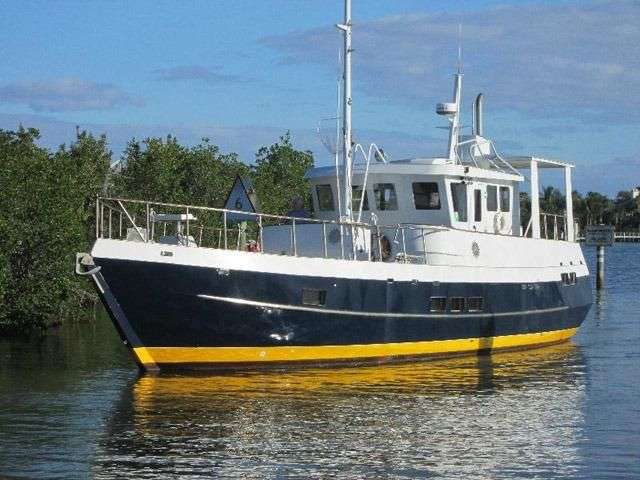
|
SPRAY 52
This fine example of the all STEEL HULL & ALUMINUM
SUPERSTRUCTURE SPRAY 52 was built by Gil Davenport from cutting files that he
had cut locally.
|
|
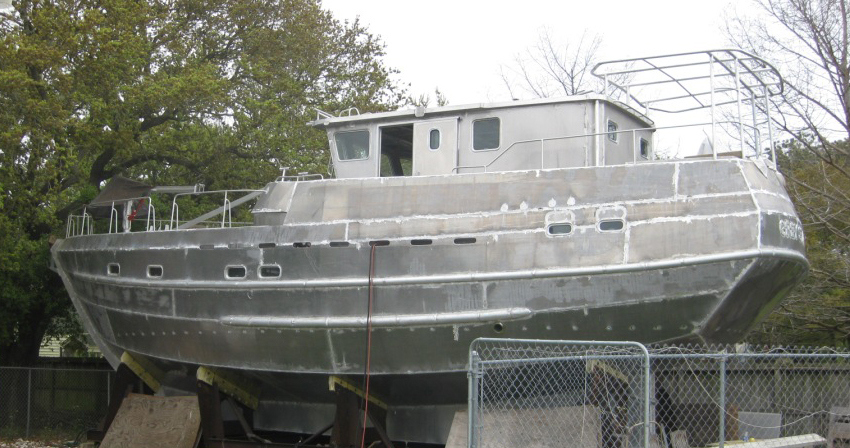
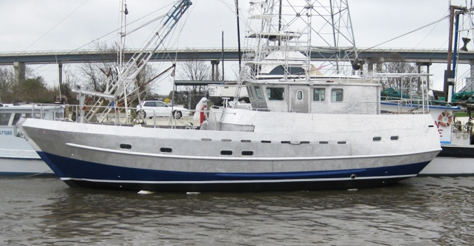 |
LEFT: This fine example of the all
aluminum Spray 52 was built by Andrew Shatillo from Bruce Roberts Spray 52 cutting files
... he had
the STEEL OR ALUMINUM PLANS & CUTTING FILES cut locally.
EMAIL FROM SPRAY 52 BUILDER
Gentlemen,
Here is the progress update on our Spray 52. The major framing has been
completed. So far, everything looks good. As a matter of fact, the longitudinal
lines look so good it is almost a shame to cover them with plate.
Next, we will try to fit the deck plate (to
check the overall dimensions). Take a look at the pictures,- we do enjoy them.
Thanks, Andrew
SEE MORE SPRAY 52'S |
|
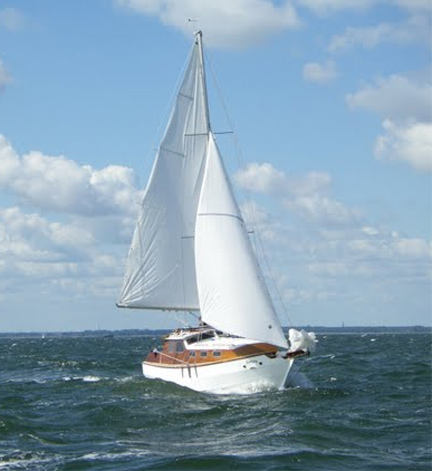 |
SPRAY 27
This WOOD EPOXY Spray 27 was built in Germany and the builder
was kind enough to supply us with STEP BY STEP building instructions in
photograph format ... these step by step building photos are included with
the STUDY PLANS and with the complete plans and patterns.
SEE MORE |
|
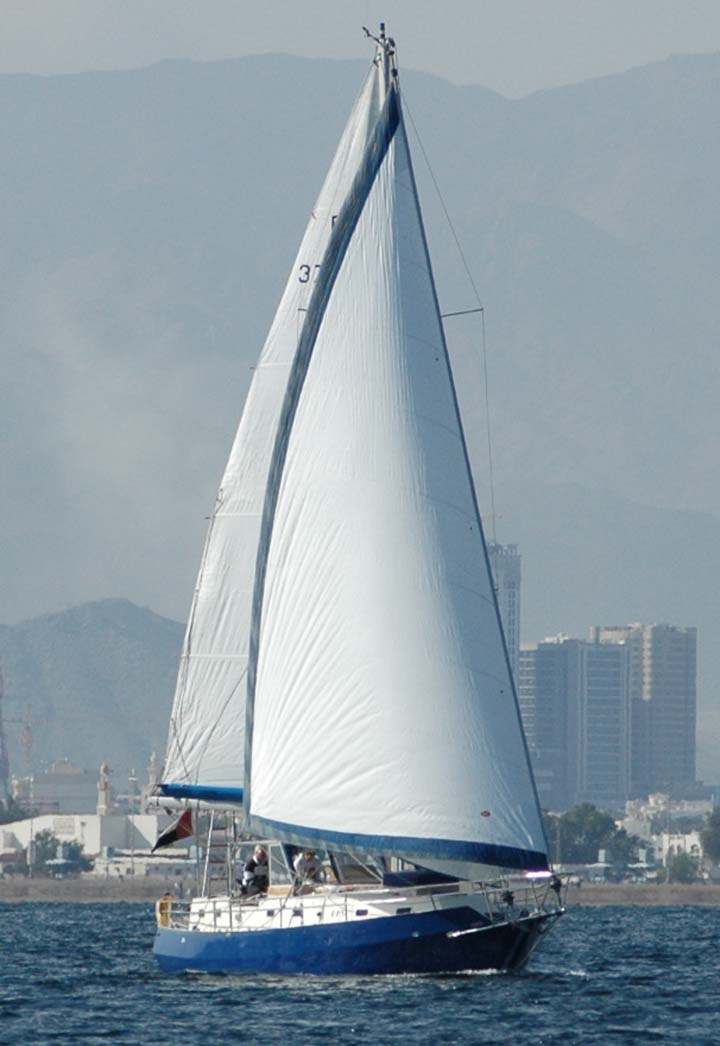 |
SPRAY
370 A
FROM DUBAI.
SEE MORE SPRAY' 370s
Dear Bruce,
Finally some pictures of her sailing! I have had a few
trips up and down the coast from Fujairah and as always
she behaves well.
I am lifting her out later this month
for antifouling and I am using Cuprotect System as it is
guaranteed 5 years and purported to be a 10 year plus
treatment. I will let you know how I get on with that.
She now has davits on the back with a Niccollslite NN10
nesting dinghy hanging from them. On long trips I can
put the dinghy nested on the foredeck. The watermaker is
on the way Ultra Whisper 600 from Sea Recovery.
I would just like to
say how pleased I am with the Spray 370 and thank you
for all the support you and Hal have given me during the
build. Best regards Bill Wigan, Dubai.
SEE MORE SPRAY' 370s
NOTE: THE
LATEST SAILING PHOTOS OF THIS SPRAY 370 ARE INCLUDED IN
THE STUDY PLAN PACKAGE FOR THIS DESIGN.
|
|
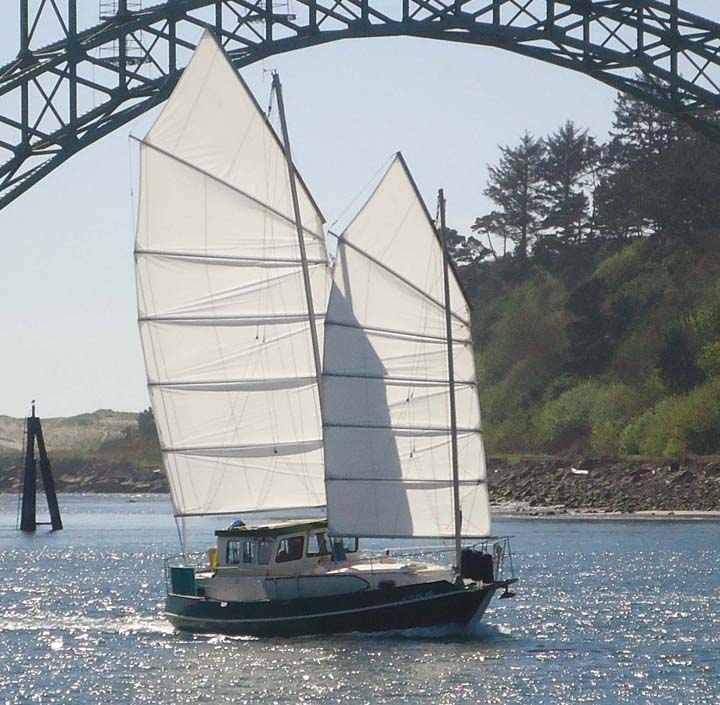 |
SPRAY 370 B Built by
Rod & Dee Palanca
We have launched in Newport, OR.
We have lots to do on the boat. We also plan to
travel to see family and friends as well as go fishing and
crabbing and just have fun.
SEE MORE SPRAY' 370s
|
|
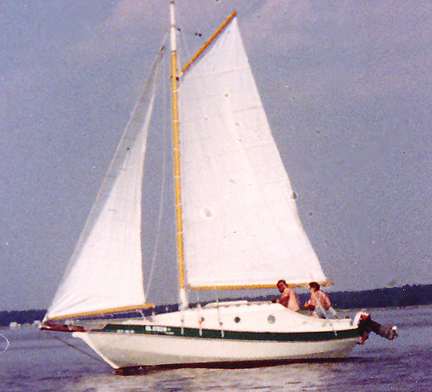 |
SPRAY 27
Version A (Standard Coach House)
Hi, Bruce:
In September 1999 I had the transom plate rolled and it was the first plate I tacked
on my boat (27 Spray). Well, I would like to let you know that yesterday July 22 I
finally finished welding the whole hull. Considering I left for last the keel plate I had
a professional welder finished it. It looks real strong. Now I can concentrate in sanding
the hull and prime it so I can roll it over. Maybe two weeks. Thank you for your
support...Art
SEE MORE |
|
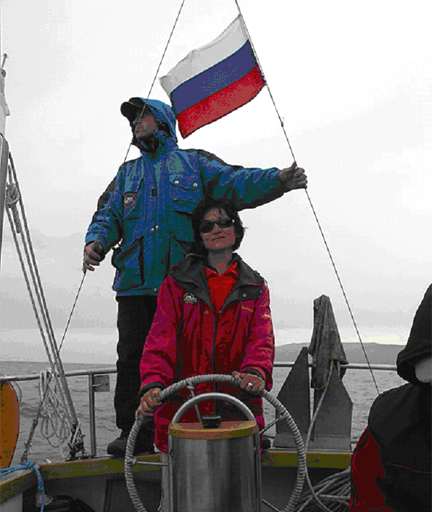 |
Spray 27
Greetings, Bruce.
My name is Igor. I am a Russian architect.
Excuse for the bad English as this is an electronic translation. I live in
Siberia near to beautiful big lake Baikal. I very much wanted to construct a boat
and 4 years ago I found on the Internet the description of your Spray 27.
You have sent me drawings by e-mail. I have a
little changed the project. 2 years proceeded construction. The hull -
metal, with a wooden cabin. I have named her *Mobi Dick*. In August 2006 I and my wife of 2
weeks travelled across Baikal.
On travel the boat has very much liked me.
She is reliable. She is not overloaded with sails. Allows me to operate
alone.
Long Keel is super. She goes against a wind! Many friends have become
interested in this project and now 3 more hulls are in work. I want to thank you for the
successful project. Best regards! Igor V.Logvanov. SEE MORE PHOTOS OF THIS BOAT IN
STUDY
boat plans PACKAGE |
|
![s22-06[1].jpg (15817 bytes)](public/HTML/images/s22-06[1].jpg)
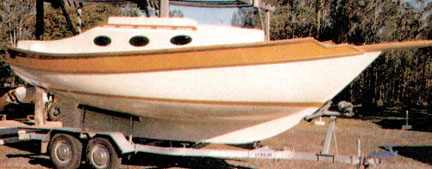
|
Spray 22
Here we see the first Spray 22
that was built at our Marine Park boatyard in Brisbane Australia.
Andrew was anxious to see how the Roberts Spray 22 would
handle as a single-handedboat. Most of his sailing is done either alone or
with his wife as crew, and generally he likes tohandle the boat on his own.
He invited Peter McCoy along to do the actual sailing, for that would give
him the opportunity to study objectively the boat’s handling in the
conditions theyexpected to experience during this first sail.
Andrew wrote: ‘Well, we got our 25 knots all right, and then
some. The day started off with thesoutheaster blowing at a steady 10 knots.
At this wind speed, the Spray 22 carried her full gaff mainsail with ease -
a great feeling as she sliced through the short chop. Soon the wind piped up
to 15 knots. We put the Spray through her paces, full sail was =still
carried and we tacked, and brought her hard on the wind. She sailed closer
to the breeze than I had hoped. I guess the proportionally deeper keel was
doing its job. OK, so far so good.
The boat was mostsatisfactory upwind, and as I had some
experience with the Roberts Spray 33 this did not come as a total surprise.
I expected at least creditable upwind performance. By now, the wind had
increased to 25 knots and it was time to take in a reef. With the jiffy
reefing set-up we have, reefing the gaff mainsail could be handled by one
person, again a nice thought for my single handing in the future.
Sailing downwind and reaching were something of an
anticlimax. Almost anything will perform well on these points of sailing.
The Spray scooted along, feeling comfortable and secure at all times. It is
certainly a boat for the whole family to enjoy and a boat I will be most
happy to single-hand at any time. For those who prefer it, a Bermudan sail
plan is now available, which will appeal to those who want the simplest of
rigs.
The Spray 22 is easily trailerable and
although we do not recommend this boat as long distance voyager; many Spray
22's have made some interesting passages.
SEE MANY MORE
PHOTOS OF THE SPRAY 22 ON THIS PAGE. |
|
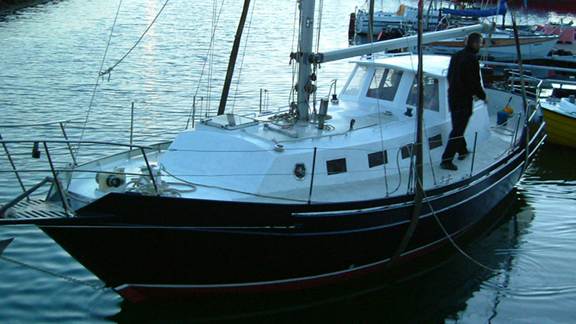 |
SPRAY 33 PILOT HOUSE
This Spray 33 was built in the UK and has
made three Atlantic crossings to the US and and finally back to Iceland
where the new owner sailed her after purchasing her in the USA.
Hi Bruce, I took the Kangaroo out for a
another hop today in
a force 5-6. Pure pleasure!!!
Slow graceful movement, balanced helm , stable like a rock . The mainsheet purchase works
fine now after some minor modification.
Other boats on the bay where heeling over far and their crews busy pulling
strings . I was drinking coffee with my wife in the cockpit.
Regards Asi
SEE MORE
SPRAY 33's |
|
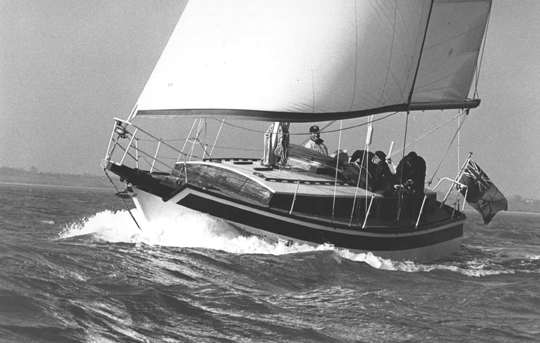 |
Spray 33
Fiberglass,
Steel or Wood / Epoxy
The Spray 33 is a very "Powerful" cruising boat - capable of
taking you anywhere you care to go !
SEE MORE
SPRAY 33's |
|

This is how the Spray 28 could
look with a small pilot
or dog house at the forward end of the cockpit.
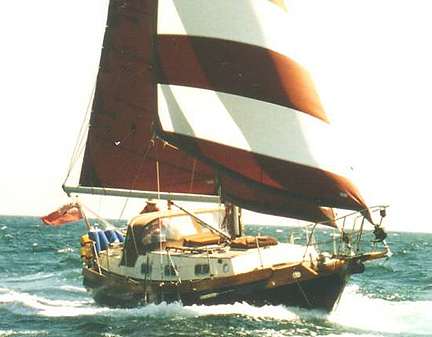 |
Spray 28
Steel or Wood / Epoxy.
Good
Morning,
I have a steel Roberts Spray 28ft junk rigged. I
have owned it some 25 years, and it was built 30 years ago. Still
excellent, and wouldn't change it. I have a question which to date
have not been able to get an answer to, and hope you can help. My boat is
presently fitted with a 29Hp Volvo Penta 2003 raw water cooled 3 cylinders.
It is at the age for 'Eventide' and am wondering if a smaller motor could
be fitted to give more space, and same performance, say 18hp.
Best
Regards, Terry Yacht 'Si Hai' Malaysia
BRUCE REPLIES:
Yes something in the order of 18 to 20 hp would be ideal for your Spray 28.
BRUCE REPLIES:
Yes something in the order of 18 to 20 hp would be ideal for your Spray
28.
MORE
FROM TERRY:
Hello
Bruce, have attached some
pics of 'Si Hai' We converted her to Junk Rig many years ago. Home made
sails, this is the second set. Originally we made the masts of Hoop pine
from Australia, but the ravages of the climate in SE Asia dealt them a death
blow. The present masts we had made in Malaysia of 3mm steel and hot
dipped.
10 years on still very nice.
Cheaper than the timber ones, and lighter. This boat saved our lives 4
years ago, when we were hit at night by a large trawler (see Noonsite for
details) Extensive damage, but no leaks, and managed to get into port in one
piece.
Needless to say the trawler
did a runner, and nothing was investigated by the maritime authorities
here.
We spent 19 months repairing
the damage. New steel plates, deck, flat bar etc. welding was excellent by
two young guys from Myanmar. Best Regards Terry & Ana 'Si Hai'
SEE MANY
MORE PHOTOS OF THIS AND OTHER SPRAY 28'S |
|
![s28f[1].jpg (23303 bytes)](public/HTML/images/s28f[1].jpg)
|
Spray 28
"K*I*S*S
K*I*S*S has cruised to Norway, Ireland, UK, Holland, down
to the Med, back to UK and up to Scotland where she now in based.
One of several Bruce Roberts
previously owned boats.
This custom built Spray 28
K*I*S*S was formally owned by
Bruce and appears in the book "Illustrated Custom Boatbuilding".
We recommend that you read this hardcover book - Order now and we will pay the postage.
At left we see K*I*S*S shown her with her
new owner Ian Crosfield and partner Marilyn Chantler.to the
SEE MANY
MORE PHOTOS OF THIS AND OTHER SPRAY 28'S |
|
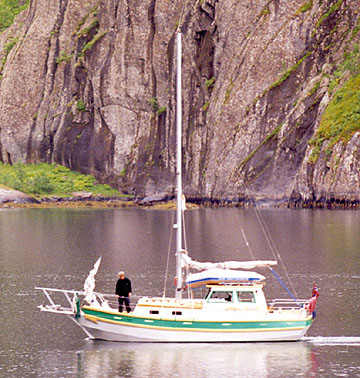 |
Spray 28
Steel or Wood / Epoxy
Owner: Karl Gustav Nilsen NORWAY
SEE MANY
MORE PHOTOS OF THIS AND OTHER SPRAY 28'S
|
|
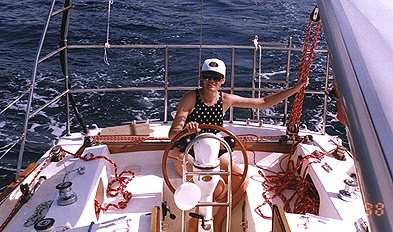 |
SPRAY 33 "Donegal
Breeze" Joan Mc Dermott at the helm of the Spray 33 that she and husband John built in Oman
and more recently sailed home to Ireland.
SEE MORE PHOTOS OF THIS BOAT IN THE STUDY boat plans
PACKAGE
SEE MORE
SPRAY 33's |
|
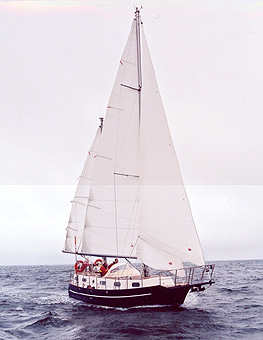 |
Centennial Spray 34 /
36
SEE MORE CENTENNIAL SPRAY 36
This Centennial Spray 34 was fitted out the
same way as we show for the Centennial Spray 36 ... worked out well for this
owner .. see some interior photos below. |
|
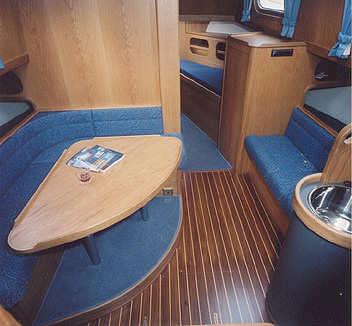 |
Centennial Spray 34 /
36
SEE MORE CENTENNIAL SPRAY 36
This Centennial Spray 34 was fitted out the
same way as we show for the Centennial Spray 36 -Note attractive interior -
this is truly a beautiful boat the the owner is most pleased with the
performance.
There are several more photos of this boat on the Study boat plans on
DOWNLOAD or on USB Memory stick.
|
|
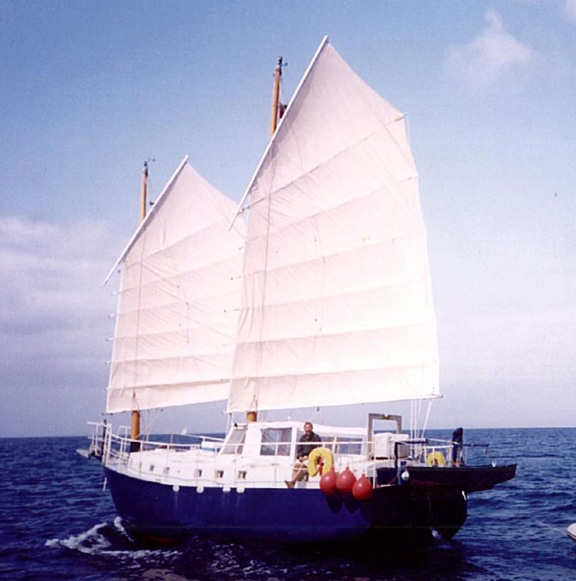
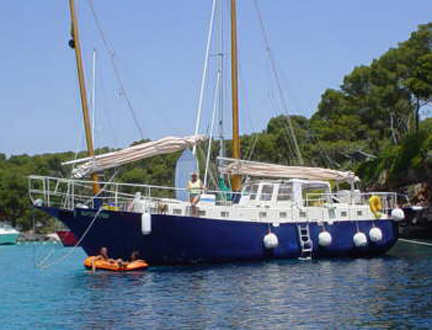 |
Spray 38
"Ruffles Spray"
SEE MORE SPRAY
38
Hi Bruce,
My wife and I have completed a
Spray 38 in 2001. We bought the boat plans in 1996 from your UK rep. It
took me 5 years to complete her and she is junk rig.
We sailed Ruffles
Spray from UK to the Med and cruised there for 2 years. The boat
looked after us magnificently. Even in 42 knots of wind sailing hard
on the wind she behaved impeccably.
The junk rig works well on a
Spray and I can recommend it. Next
year we are heading to Turkey to continue our cruising.
Best regards Mike
& Ann Ruffles
S/Y Ruffles Spray
|
|
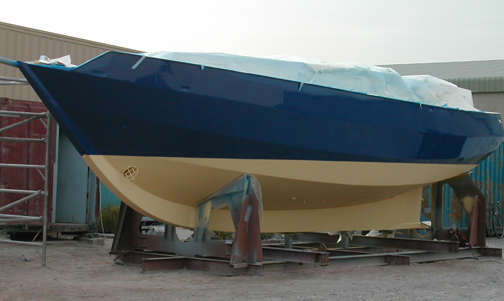 |
Just an update on my progress. I have just
finished painting the hull and primer under water line. I am very pleased
with the result and I hope you agree.
All the machinery and appliances are
installed, wiring 95% plumbing 40%. Interior joinery fore and aft well on
the way. Galley and saloon not really started yet. Leaving this until
last.
I am pleased with the progress as it is 20
months since the first plates were tacked together. Best
wishes to all, Bill Wigan Dubai
|
|
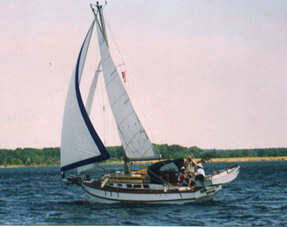
Trunk cabin gaff rigged version
Spray 27 sailing in Virginia
|
SPRAY 27
Builder writes:
Hi Bruce, we had a hull-turning
party for our Spray 27 today and it went beautifully. I'm building it in a steel
shed 32' wide. We ran two big nylon ropes under it as slings tightened with
come-alongs, lifted it off the form, then with ample helpers, turned it over within the
rope slings, pulled out the form, and put it down on blocks. It looks very imposing,
now, and very attractive, too.
I am building in plywood/epoxy,
and I'm the guy who modified the design for "epoxy chine" construction--no real
difference, I just have lots of fillets to make now that the hull is turned over. I
live in Montana. I'll get our pictures developed and get them to you. Also, my son
will be posting some on our website for us. Is it easier for you to simply adopt
them from that? Either way is fine--we'll get all this done, hopefully, within a
week.
Perhaps you'd pass on the word
to others who have bought Spray 27 boat plans recently that I'd sell them the building jig
(very well built, I might add) and all the temporary frames. This would get someone
off to a flying start--they'd only have to use their patterns for the stem and the
bulkhead at station O--the rest would be ready to go. All are made of pine with
glued plywood gussets and, of course, waterline and headstock lines drawn on. I'll send
you some pictures once they're developed. Thanks for a fine plan. --Dan Aadland
SEE MORE OF THIS BOAT |
|
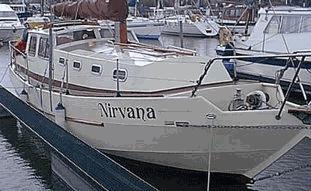 |
SPRAY 27
Photo on the left shows a Spray 27 Pilot house version in UK
"NIRVANA" Bruce, I received the boat plans for the Spray 27 today. I must say, I was
more then a little suprised when I found the boat plans for the trailer and the dinghy
included. You really know how to make a guy's day. Although, I've only had time to give
them a cursory look I'm thrilled with the boat plans. And at the price I paid for them on the
special, I didn't buy them, I stole them! Thank you
for the great day. Tom Walsh
MORE INFO SPRAY 27
|
|
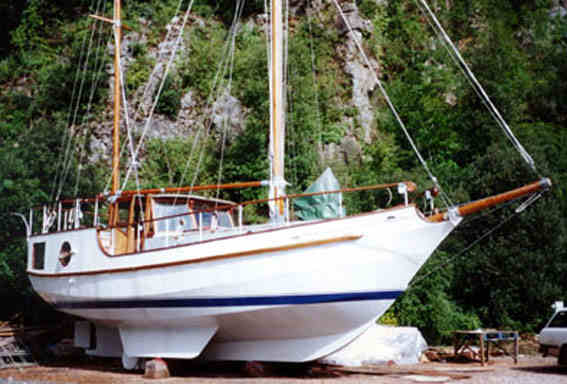 |
Spray 40
"Festina
Lente"
From Bruce: About three years ago, I did have the
privilege of having dinner aboard this beautiful Spray 40 when she was being cruised in
the Med. I wonder where she is now?
See Roberts
Spray 40 S.F.W. for more news about the various Spray 40's |
|

See more on
JUNK RIGS |
There are many Spray's
that have been Junk rigged.
SEE MORE ON THE
Roberts
Spray 40
|

ABOVE: This steel Centennial Spray 38 was built in Sweden
|
CENTENNIAL SPRAY 38
Steel version.
Bruce, G'day,
I have been promising an update and pictures for a while now... finally the pictures are
on their way snail mail.As you will see I have chosen a couple of outside pictures to give
you some idea of the finish we have attained, bearing in mind this is just the first
proving coat . I have also given you a picture of the stern to show the
modifications to take the junk rig. I have also included some pictures of the partly
finished head to give you some idea of the interior finish we are trying for as well.
The carpenter we have doing the interior fit out has worked for Alloy
yachts on some of the super yachts and is a real craftsman. To give you some idea of
the type of person I have included a picture of his tool box - a work of art initself.
I'm going to have a plaque made up with the boat name and the builders with a foot
note of "built in New Zealand by craftsmen"
All of the people that are and have worked on the boat are really impressed with the
design and the finish, I think a couple of them are looking to build a spray for
themselves. With the amount of interest I have had maybe I should start using Spray Maker
to market Bowline Boats and offer to build Sprays in New Zealand and ship them to the US
or where ever, with the current exchange rate it would be cheaper and the quality is world
class - a new line of super cruisers from New Zealand boatbuilding industry. More to
follow over the next few months as the masts come together.
Regards Pete
SEE
MORE CENTENNIAL SPRAY 38's |
|


Boat plans & Full Frame Patterns -
Round Bilge Steel,
Aluminum or
Wood / Epoxy

|
Centennial Spray 38
Wood Epoxy Centennial Spray 38
Built by Rob & Nina in New Zealand
SEE
MORE OF THIS CENTENNIAL SPRAY 38 |
|
 |
Centennial Spray 38
This boat can
be rigged as a gaff ketch, gaff cutter, Bermudian ketch or cutter plus a
variety of other rigs including the Junk schooner etc. All available sail
boat plans are shown in the study boat plans on DOWNLOAD or on USB
SEE
MORE OF THIS CENTENNIAL SPRAY 38
|
|
1.
SEE MORE
SPRAY 33's
Re: Spray 33 in Kemer/Turkey mentioned to you by
Suat Zeybek S/Y Blue-Belle, British, Bermudan Cutter, Homeport London, build
4mm steel, owned and sailed by Derek and Hulya Leigh.
Dear Bruce,
We arrived at Park Kemer Marina/Turkey in July 2004 after our return trip
across the Atlantic from Florida/USA. My wife is Turkish, and, being one of
the few Turkish girls to sail the Atlantic twice, is attracting a lot of
media attention here, needless to say so is the boat. Our Spray was featured
on national TV in august and created enough interest to warrant a repeat
showing. Since then we have been featured in four Yachting Magazines- the
Antalya Regional Magazine- and a video of Blue-Belle crossing the Atlantic
was shown at the Antalya Boat Show to a very enthusiastic audience. The
Turkish Chamber of Shipping have also conducted an interview to be featured
in their commercial publiion 'Turkish Shipping World'. We have a constant
stream of visitors and Suat Zeybek of the Dive Centre is one of our
regulars. He is keen to build a Spray 36 and I believe he has already
purchased the boat plans.
Anyway, so much for the present, let me give you a brief history of
Blue-Belle to date. In 1987 I was looking for a long distance load carrier,
big enough to cross an ocean comfortably, but small enough to be easily
maintained. I purchased the boat plans of your Spray 33 and began building
on the south coast of England.
Due to working abroad, I didn't launch her until 1992; I would probably
estimate that as a full time build project to high standard of finish, she
would take 2 to 2, 5 years for one man to complete. She is built in 4 mm
steel and is hot metal sprayed with aluminum both inside and out. She is as
per your version B boat plans a part from lengthening her to 34 feet on
deck, in order to incorporate a double self stowing anchor roller assembly.
Upon completion she was then stored ashore for a further four years while I
was away earning the cruising fund.
Her maiden voyage was in the autumn of 1996 London to Antalya/Turkey aprx.
3500 miles single handed. I hadn't fitted any self steering as yet, so this
first long passage was a good test of the Spray's legendary self steering
qualities. If you take care to balance the sails she will steer herself for
amazingly long periods of time.
In Antalya my Wife and I were married and we moved on board to begin our
full time cruising life style. Now I really did begin to appreciate the
Spray's load carrying capability, I have never seen so much stuff poured
into just one boat.
We spent two full seasons cruising the Med and in September 2000 departed
Portugal for the Cape Verde Islands via the Canary Islands. December the 1st
found us leaving Mindelo/Cabo Verde and bound for Barbados. |
2.
SEE MORE
SPRAY 33's
We still didn't have any self steering fitted, but then
again neither did Slocum. No problem. Blue-Belle took 16 days to make the
2037 mile crossing, that's an average of 127 miles per day. Her best days
run being 147 miles. For a heavily laden cruising boat with a 28 ft water
line she could certainly turn in a decent passage time. We were delighted
with her. We also found that running downwind she didn't roll as much as
other boats I'd sailed under similar conditions.
Maybe the chines have something to do with this. We spent the next 2,5
years cruising the Caribbean, Bahamas and the US Intracoastal Waterways. The
Spray's shoal draft was paying dividends. June 2003 and we were on our way
back across the Atlantic. We did purchase wind wane steering gear in the
states, but were so busy being tourists, we didn't have time to fit it. I
think that only the crew of a Spray would contemplate carrying their self
steering gear as deck cargo prior to an Atlantic crossing.
Our North Atlantic Passage was the usual mix of gales, calms, and
occasionally some decent sailing. However we ate well, slept well and apart
from blowing out the genoa suffered no damage. In Spain my wife had to fly
home to cover a family emergency. So once again I single handed to Turkey,
finally arriving to the fabulous reception mentioned earlier. This winter we
intend to haul out and I will finally get round to fitting the Wind vane and
steering gear. For as my wife says "It will look so much nicer dear, hanging
on the transom".
In conclusion we find the Spray to be a wonderful sea boat, and is a lot
faster than she looks. When running in gale force conditions we find that
our heavy weather staysail, sheeted flat amidships (a technique used by
Slocum in his book) works well. The bow showing no tendency to dig in
despite all the weight we carry up forward. One mistake we made in the early
years was in reefing her down too early; the boat is very stiff and sails
well in heavy weather. In storm conditions when it is more prudent to stop
and we either heave to or lie to a parachute anchor streamed from the bow
and attached to a bridle led back to a cockpit winch. In this manner we feel
safe and secure.
So, would we part with our Spray? Would we change her for something else?
No - not ever. After 8 years and 35.000 miles we finally have our ultimate
cruiser.
Thanks Bruce, you gave us a great boat.
Kindest regards,
Derek & Hulya
S/Y Blue-Belle
Antalya/Turkey
SEE MORE
SPRAY 33's
|
| Hail Bruce from California!
I'm a marine surveyor and great fan of your designs - as a Whitbread Vet and childhood
dreamer of the original "Spray" - love to get one of your "Spray"
books. Just surveyed a reported 1980 40' named "Osprey" with "factory"
hull (Pacific Northwest /Canada / USA?) and STEEL OR ALUMINUM PLANS & CUTTING FILES interior - can you pass on any greater
detail on where the hull and deck may have been laid up or any other details if
"Osprey" rings a bell any where!!! Thanks and happy new year!
Best regards, Capt. R. Scott Thomas - 40 Years Delivery IOR Boats - 2,302,500 miles.
|
Bruce, I have been a long-time admirer of your design work.
I finally got the chance to board a Spray for the first time yesterday. ( I almost drove
off the road as I craned my neck to get a better look at her.) She is moored
alongside the St. Pete (Florida) Yacht Club Sailing Center Building. Her builder is
an interesting Polish lad by the name of Maciej Rosochowicz, he told me that he is planing
a voyage for disabled sailors in the near future. I can't imagine a more
stable platform.
He sang your praises all the while that I spoke with him. He
described an early voyage of MACIEJKA in short, irregular, fifteen foot seas as that
of a duck climbing up a wall of water and then sliding down the other side. He
beamed with delight as he told me how well she steered herself. He is truly happy.
You have accomplished a great deal more than just designing a fine vessel. You have
made a difference in the human condition. Witness the smile on his face and the
sparkle in his eyes as he speaks about his floating mistress. Your SPRAY has immeasurably
improved his standard of living.
I wish you and yours continued success. Sincerely,
Nils Klykken |
|
 |
Here are some
pics of our Spray 36 "Taranea Spray". Taranea Spray was built by me, Hans Jurgen
Hoernicke in Västerås, Sweden.
We sailed her for the first
time in 1998 and all I can say is that Spray 36 was the right choice. Last summer we
traveled from Stockholm, Sweden to Hamburg, Germany. Her balance is fantastic, we
are very satisfied." Regards, Hans Jurgen Hoernicke.
SEE MORE -
Click here |
|
 |
Spray 40 "IDUNA
3"
Dear Bruce,
apologies for the delay in reply. I have been out of station for several weeks & my
E-Mails have finally caught up with me.
The vessel is called Iduna III, she is a pilothouse ketch Spray 42' built
1984 (Capetown) & I located her in the Rio Dulce, Guatemala in September 1997. I
traveled to Guatemala from Doha, Qatar (where I am based for work) to inspect her &
agreed to purchase her in December 1997.
MORE INFO SPRAY 40 |
|
 |
SPRAY 55 B
Spray 55 under sail in the Caribbean.
You will note that the customer has chosen the schooner staysail rig as we
designed; see above left.
SEE
MORE SPRAY 55's
|
|

Bruce,
What a year.... I have not had time to give you updates on our Spray... I see that you
still have the picture on the CS38 page. Well I WILL send over some new pictures by
snail mail. We have finished the hull and got the first coat or Green gloss on the
hull - it looks great, you cant even tell that it is steel it looks that good. |
"SPRAY MAKER"
This weekend our Centennial Spray 38 "Spray Maker" will
be blasted ready for the painting and fit out to start. I have been taking photos
along the way so have a good record of the build process, if you are short of material or
would like something for the Spray News let me know.
My wife - the writer in the
family - will be producing an article or two for the Australian Spray Society so we could
use this or a modified version. I thing Spray Maker will be a first in a number of areas,
the first Centennial 38 in New Zealand and the first to be junk rigged, so someone in the
world of Spray's may be interested.
By the way our builder, Bowline Boats, is really
impressed with the boat and design and is looking to specialize in this style of yacht.
Cheers Pete
SEE MORE
CLICK HERE
|
|
 |
Spray 40 'Pilot'
Hi Bruce, We tack weld the first twelve frames I introduce my team
Dany and Paul, I am Rodolfo Garcia Susini from Argentina Patagonia Bariloche.
my e-mail nick name is "Vicet"
MORE INFO SPRAY 4O PILOT |
|
 |
Spray 33
"ALEAH"
This Spray 33 is owned
by Robert Lind of Washington State.
A beautiful boat which Rob enjoys
sailing in the San Juan Islands.
MORE INFO SPRAY 33 |
|
 |
Spray 36
"Sarwaya"
Owned by Andy and Meredyth Haris
"This is what it is all about. "Sarwaya"
at anchor off one of the many Balearic Islands."
MORE INFO SPRAY 36 |
|
 |
SPRAY 33
"SPARTACUS"
MORE INFO SPRAY 33 |
|

 |
SPRAY 33
This beautiful
FIBERGLASS Spray 33 was built in California and I was personally
present at the launching ... there are many more photos of this boat
shown in our Study Plans package for the Spray 33.
MORE INFO SPRAY 33\ |
|

 |
Two more Sprays These from Australia.
Left: Spray 33
Right: Spray 38
MORE INFO SPRAY 38
|
![s40a-05[1].jpg (8914 bytes)](public/HTML/images/s40a-05[1].jpg)
Peggotty'
This steel Spray 40 has cruised extensively
including a
trip to Antarctica |
Spray 40
Hello Bruce, Just wanted to drop you a line and let
you know that the boat plans for the Spray Pilot 40 arrived the other day. There sure are
a lot of detailed drawing which will help immensely with the project. I have one
question, do the pattern lines for the frames represent the outside or inside dimensions,
in other words, would I lay the flat bar on the outside or the inside of the lines in
relation to the center line?Thanks again for the
boat plans. Steve
ANSWER: The frames are built inside the pattern lines .... only the
plating is outside these lines...Bruce
MORE
INFO SPRAY 40 |
|
 |
Centennial SPRAY 46 "Shiloh"
Cruising off the North Carolia coast
in the US |
|
 |
Spray 40 Pilot
This is a special version of the Spray 40.
This photo was taken when the boat was moored near our office in Annapolis. The Spray 40
Pilot was purchased by a Canadian couple - Where is she now ?
MORE
INFO SPRAY 40 |
|
 |
“BOUNDER”
Ketch Rigged
Custom SPRAY 45
Construction West System,
using double strip plank and epoxy resin,
and covered with a heavy epoxy/fiberglass skin. Outside ballast keel of
five tons |
|
SPRAY SOCIETY |
LIST OF SOME OF THE MANY SPRAYS CURRENTLY CRUISING WORLD - WIDE |
Below is a sample of the interesting articles and information about the
Spray that can be found on the
SPRAY SOCIETY
web site
Into the Ice
A lone SPRAY sailboat drifts across the
northern Atlantic.
On board, skipper Robert Graf is desperate
for sleep, but the island-sized icebergs surrounding his vessel preclude him
from taking his weary eyes off the horizon for a moment too long.
"You can't even take a chance on getting
close to them because something could fall off them and crush you. Plus, they're
notorious for turning upside-down and if you're too close they'll upset your
boat," Graf says. "You're like an ant in a big field of elephants."
Navigating these icy behemoths for days on
end with no one else on board to keep watch meant that Graf had to sleep in
20-minute intervals. He would wake to his trusty alarm, pop his head out of the
cabin to ensure the icebergs were still a safe distance away, then return for
another round of shuteye. "That's one of the real challenges when you're by
yourself - there's nobody watching where you're going," he says. "There's that
20 minutes where a lot can happen when you have to sleep."
Seated in his North Vancouver living room,
a light autumn rain taps against the window as the 61-year-old sailor recalls
the iceberg-ridden labyrinth he sailed through before entering and successfully
crossing the Northwest Passage.
The voyage makes Graf the ninth person in
the world to transit the Arctic sea corridor single-handedly, according to the
Scott Polar Research Institute, which keeps a running tally of maritime
traverses of the Northwest Passage. He is the first Canadian to cross the
passage alone in a sailboat and the first Canadian to transit solo without
needing assistance, according to the institute.
But Graf didn't set out to break any
records.
"I didn't realize that was all going to be
such a whoop-dee-doo," he says modestly, explaining he has always been intrigued
by the history of the waterways around Canada's northern archipelago.
"It just seemed like a real test of your
endurance and your stamina to do it, but also your skills to get through there,"
he says. "I'd always read about it and dreamed about it and it was on my list of
places I would like to sail."
For centuries, the Northwest Passage eluded
sailors. Originally sought by explorers as a potential trade route between
Europe and Asia, the ice-blocked waters frustrated many an expedition. In 1845,
two British ships led by Sir John Franklin famously disappeared. Records show
the entire crew perished due to a combination of cold, starvation, scurvy,
pneumonia, tuberculosis and lead poisoning. Underwater archaeologists only just
discovered one of Franklin's sunken shipwrecks last year.
The Northwest Passage was first
successfully navigated by Norwegian explorer Roald Amundsen in 1903-1906 (he and
his small crew over-wintered three times). The first Canadian voyage was made by
the St. Roch RCMP schooner, captained by Henry Larsen, in 1940-1942.
According to Capilano University geography
instructor Charles Greenberg, a record number of 30 vessels transited through
the Northwest Passage in 2012 and, in 2013, for the first time, a large bulk
carrier passed through. Only 17 vessels managed the trip in 2014 due to a short
and cold summer. The Northwest Passage "is a web of several possible routes,"
Greenberg notes in an email - somewhat like a corn maze. Over the past 40 years,
sea ice cover has declined by around 25 per cent and is about 20 per cent
thinner overall and up to 40 per cent thinner in certain areas, Greenberg says.
Thinner ice is more susceptible to melting and with more melt comes more open
dark water, which absorbs solar energy and holds heat longer, making it harder
for ice to form the next year.
A "very tiny benefit" of this climate
change might be commercial use of the Northwest Passage, Greenberg says. Still,
Arctic storms, shallow waters and icebergs pose risks for ships.
A seasoned sailor, Graf has completed many
endurance voyages, including a marathon three-year solo sailing journey around
the world. This was his first trip to the far north. He departed Amsterdam on
June 15 in his 15-metre ketch named Drifter Way. The sailing vessel has twin
masts and its hull design dates back to about 1840, though it is made from
modern materials.

Drifter Way
"It's big, it's slow, it's very safe,
carries a lot of supplies. It's actually kind of big for one person, but it
handles very well in storms so it's pretty forgiving," Graf says.
The first leg of his journey involved
dodging busy ship traffic, wind farms and offshore oil rigs en route to Norway.
He stayed there a few days before embarking for Greenland via high latitudes to
take advantage of west winds generated by powerful storms. There was excitement
along the way - both friendly and frightening. South of Iceland he encountered a
pod of some 200 pilot whales that travelled alongside him for a couple of days.
And on the way to Greenland he was hit by his first north Atlantic storm. "The
waves were getting big, they were getting maybe 25 feet high," Graf recalls.
It wasn't long before he lost control of
his boat. It took an hour to get back on track, but by that time the wind had
blown him off course toward Newfoundland. "In the morning, everything looked
better. But at the time, for a number of hours, I had that sick feeling that ...
if it gets worse than this, it's going to get really scary." Graf sailed Drifter
Way to the south of Greenland where he stayed for three weeks, first at the
Polar Oil fuel depot south of Nuuk and then in the west coast town of Maniitsoq.
Travelling up the west side of Greenland
proved difficult due to strong head winds and massive icebergs. Making matters
worse was the frigid temperature; it never got higher than four degrees Celsius
inside the cabin. Dampness permeated Graf's thick clothing and although he
brought fuel on board, he opted to conserve it for his motor in case of
emergency rather than use it for heat.
On Aug. 16, Graf arrived at Lancaster
Sound, the entrance to the Northwest Passage. He proceeded west to Resolute,
Nunavut, where he stayed two nights and got more fuel before making a hard left
into Peel Sound. From thereon out, he saw very few other ships.
"Once I started travelling south in Peel
Sound, that's when I hit my first ice," he says.
According to Canadian Ice Service, the
water was three-tenths ice. "That means the whole surface is covered in 30 per
cent ice and you have to weave your way through it."
Zig-zagging around frozen sheets was
tiring, Graf says, but the view was spectacular: the vast white expanse was
covered with hundreds of seals lined up in rows like fat cigars. Victoria Strait
was perhaps the most exhausting leg of Graf's journey. He spent more than 24
hours motoring through drift ice. There was an audible grinding noise near
Collison Peninsula as the frozen sheets merged together, but he managed to
squeak through the strait without a minute to lose.
"It just closed right up into a solid mass
of ice as far as I could see. It was one chunk of ice and it started to move in
one direction. My boat would have been just crushed."
From Resolute Bay to Nome, Alaska - a
distance of some 2,400 kilometres - Graf anchored to sleep only four times. The
rest of the voyage he stuck to his 20-minute sleep cycle in hopes of avoiding
icy collisions.
On Sept. 10, off the coast of Barrow in
northern Alaska, the fog was so thick Graf couldn't see much in front of him. It
was windy and there were ice floes everywhere. Meanwhile, autumn was setting in
and it was starting to get dark at night. Around 4:30 a.m., he gave up on sleep
and decided to check on his position - but he was too late. "There was this
massive big explosion and I knew there was something wrong because I saw ice
passing on both sides of the boat through the portholes. By the time I got up on
deck there just was ice on both sides."
Drifter Way had plowed headfirst into a
chunk of multi-layered ice the size of a two-car garage. Graf quickly dropped
the main sail and was able to gingerly back out of the floe, but with big waves
crashing about, he couldn't avoid crunching up the side of his boat.
Fortunately, the damage wasn't too serious and he was able to make it through
the Bering Strait to arrive at his final destination of Nome, Alaska on Sept.
14. He stayed there until the end of the month, waiting for the right conditions
to haul Drifter Way out of the water, then flew back to
Vancouver.Graf is still adjusting to life
on dry land. He's down 28 pounds after three months of consuming little more
than instant coffee, canned fish and rice. And he finds himself waking
frequently in the night after training himself to survive on a fragmented sleep
schedule.
"There's kind of a letdown when you come
back because you've got to wind down," he explains.
With the constant fatigue, cold, damp and
loneliness still fresh in his mind, the lifelong sailor is wondering if it might
be time to hang up his captain's hat.
"When I'm out there and getting bruised and
battered, I always think the sea always finds another way to punish you and
drive you crazy," he says.
"I might be finished with sailing now."
After the spring thaw, he'll retrieve
Drifter Way from storage in Alaska, repair the boat, sail it back to Vancouver,
and decide whether or not to sell it. He admits, though, this isn't the first
time he's considered retiring from sailing after a particularly trying journey.
"I usually recover and start planning another voyage," he says with a chuckle.
The
Spray Design
– A Nautical legend
Today there are many variants on the original Slocum spray design.
Back Then:
In 1894 the Captain was
given an old sailing boat, called “Spray”, which had been rotting away in a
field in Fairhaven, on the shore of Massachusetts Bay, USA. He rebuilt it plank
by plank so that “it was hard to say at what point the old died or the new took
birth.” Slocum avoided doing anything that might cause the boat to lose the
shape formed by the genius of some long-dead boat builder.
To make her safer in
uncharted waters, he removed the original centre-board and rebuilt the keel in
one solid, long run, keeping the same shallow draft that was typical of the old
Spray’s original purpose, an oyster dredger on the shallow banks off the coast
of New England. Indeed, the original Spray had a huge area of sail which was
used to trawl the clumsy oyster dredge across the bottom, and then sail home
quickly with a hold full of the heavy shellfish. Spray’s sail plan and hull
design were responsible for her uncanny ability to steer herself for long
periods. Oyster dredgers needed to be able to look after themselves as the crew
worked the trawl and the catch.
So, from a chance gift from
an old friend, Slocum transformed the old dredger into a capable deep-sea
vessel which he knew would take him safely around the world.
Who was Slocum?
Captain Slocum was no
novice in the world of sail. He ran away to sea when he was eleven, and spent
almost the rest of his life at sea, rising to be master of “Northern Light”, one
of America’s finest tall ships in the mid 1180s. He built one ship, and owned
several others, but ran into financial ruin when his last ship “Aquidnek”
foundered on a river bar in Brazil. After several years of land-based torment,
he was drawn back to the sea, and Spray was both his home and his escape pod.
Was
the Spray really a good boat to circumnavigate the world?
At the time, Slocum had only one option - the vessel that was given to him. He
originally used Spray for a season of fishing, but when that proved
unsuccessful, and no doubt unsatisfying, decided that she would carry him on a
voyage of adventure around the world. If she wasn't the perfect boat for such a
voyage, he made up for any deficiencies with more than sufficient seamanship
skills. He also modified Spray as the voyage unfolded, changes that would make
her more manageable for a solo sailor.
In 1909, Slocum said he had
the lines taken off the old Spray by a boat builder. But it appears that the
boat builder did just a few measurements, then made a half-model, the sort of
model that hangs on the walls of yacht clubs around the world. But that half
model, which Slocum swore was the exact shape of the original Spray, gave rise
to the lines and plans which have been subsequently used to construct replica
vessels over the years.
The Spray design was not
unique. In Slocum's day it was an old design, but there were still
oyster-dredgers working around the New England coast. Slocum modified the Spray
hull when he rebuilt her. For example, he removed the centreboard - a common
feature of oyster-dredgers. He also added more ribs and strengthened her bows.
Perhaps, during conversations with passing old sea dogs, Slocum got the idea of
the circumnavigation. Some of the tales his visitors told of the arctic whaling
"inspired me to put a double set of breast-hooks in the Spray, that she might
shunt ice." Why do that in a vessel he planned to use for fishing?
Is the Spray seaworthy?
"Yachtsmen pleasuring in
the 'lilies of the sea' will not think favourably of my craft," warned Slocum,
anticipating the criticism of those who juggle with coefficients. "They have a
right to their opinion, while I stick to mine."
Leaving theory and
controversy to others and devoting himself to enjoying the first single-handed
circumnavigation of the world, the uncommon Yankee (Joshua Slocum) who became
known to mariners of all nations as a classic sailor and a forthright, honest
man said simply, "I have given in the plans of the Spray the dimensions of such
a ship as I should call seaworthy in all conditions of weather and on all
seas." You can't argue with experience!
Many Spray designs over the
years since have successfully circumnavigated the world's oceans, and with the
advent of efficient engines, GPS, HF radio and other useful items, high
standards of seamanship and associated skills have become less critical. Solo
sailing voyages are incredibly difficult in any vessel, but a couple or small
crew can become quite proficient and confident in sailing the Spray design.
Those who have owned Sprays
will attest to their sea kindly abilities and lack of heeling when sailing, but
they don’t go well to windward (what heavy displacement long-keeled
shallow-draft yacht does?)
What do the experts say?
Cipriano Andrade, Jr.,
engineer and yacht designer, said of Spray: ”After a thorough analysis
of Spray's lines, I found her to have a theoretically perfect balance.
Her balance is marvelous — almost uncanny. Try as I would — one element after
another — they all swung into the same identical line. I attacked her with
proportional dividers, planimeter, rotameter, Simpson's rule, Froude's
coefficients, Dixon Kemp's formulae, series, curves, differentials, and all the
appliances of modern yacht designing, and she emerged from the ordeal a
theoretically perfect boat. For when she is underway every element of
resistance, stability, weight, heeling effort, and propulsive force is in one
transverse plane, and that plane is the boat's midship section. I know of no
similar case in the whole field of naval architecture, ancient or modern.”
One of the most remarkable
things about Spray was her ability to run before the wind under her regular
fore-and-aft rig with the helm lashed. She was able to hold a true course on her
own on all points of sailing and in the Indian Ocean sailed 2,700 miles in
twenty three days with no one at the helm. (No autopilot, GPS or engine back
then). It should be mentioned, however, that Slocum had by this time installed
the small sprit rig on the stern of Spray which would have acted pretty much
like wind vane steering.
Evidence that Slocum made
changes as he went is seen in his own words: "I did not know the centre of
effort in her sails, except as it hit me in practice at sea, nor did I care a
rope yarn about it. As a sailor judges his prospective ship by a 'blow of the
eye' … so I judged the Spray, and I was not deceived."
Iconoclast designer John
G. Hannah, known as the sage of Dunedin but perhaps better known as the designer
of the Tahiti ketch, said of Spray, "I hold that her peculiar merit as a
single-hander was in her remarkable balance of all effective centres of effort
and resistance on her midship section line." Hannah nevertheless felt it
necessary to warn prospective circumnavigators looking for a suitable vessel
that "Spray is the worst possible boat for anyone lacking the experience
and resourcefulness of Slocum to take offshore." No doubt even the most
celebrated yachtsmen thought such remote, solo voyages foolhardy enterprises.
Other details of
extraordinary sailing ability in the course of her 46,000-mile voyage are too
lengthy and well known to readers of Sailing Alone Around the World to
recount here. Slocum
What do owners say?
“We were out in 30 plus
knot winds with the headsail and main and mizzen sail up. She bounded along
nicely at near to 11 knots whilst other yachts scurried for home on their ear or
downsized sail to limp home ASAP.”
“We had salads on the
cockpit table and were cruising along nicely (and upright) and waved to a
passing yacht hard at it heeled right over. We could see her keel and skin
fittings underneath and the crew were hanging on to the windward side looking
jealous.”
"She’s a great cruising
vessel, so roomy. We don’t worry about sailing to windward - if we need to we
put on the ‘iron spinnaker’ and still get there in complete comfort. Besides,
being a cruising vessel, we only go when it suits us”.
And Slocum: Bound from
Samoa to Australia, Slocum encountered gales and heavy seas that foundered the
American clipper ship Patrician running a course south of Spray. A
French mail steamer blown off course reported seeing Spray at the height
of the storm and wondered what sad fate had befallen the little ship. Slocum's
log records that, at the time that passengers of the steamer were up to their
knees in water in the big ship's saloon, Spray was laying snug under a
goose-winged mainsail and arrived safely at Newcastle in the teeth of a gale.
What do critics say?
“A spray? Huh - they're
slow....”. A typical comment from
people usually who have never been on a Spray. And so what? Being a
cruising vessel and many used as live-a-boards (one buyer described one 40’ as a
Sydney town house), it’s not very likely they will be out in every race, every
weekend to do battle for a few more points towards some trophy.
The modern day spray:
In 1973, Bruce Roberts,
then a young boat designer in Brisbane, ( Now a not so young designer still
designing Sprays and many other sail and powerboats in 2017 ) was asked to
design a Spray which could be constructed in fiberglass. Bruce took the original
plan drawings from Slocum's book and an excellent model made by John Haskins
together with the lines meticulously researched by Kenneth Slack in his book “In
the Wake of the Spray”, and redrew them, retaining the desirable seaworthy
attributes as described by Cipriano Andrade. But to give the boat more ability
in a head sea and picking up on some of the criticisms of the replicas built
after Slocum’s circumnavigation, Roberts pulled the stem out to make it sharper,
and added more run in the aft sections. In doing so he lengthened the hull from
36 feet 10 inches to 40 feet. From all
accounts the change has not altered the ability of the modern Sprays of that
length.
Roberts, on request from
sailors wanting the abilities of the Spray design but in a smaller vessel, also
scaled down the plans to 33 feet in length. Someone later spaced the frames out
and finished with a Spray of 36 feet 10 inches – the same as Joshua’s Spray, but
with a beam of only 12 feet instead of nearly 15 feet. Since then, the Spray
design has been scaled to 22 and 27 feet (both trailerable), 28, 33, 36, 40 feet
and even larger.
In Summary:
The
one constant, reported by all who own and sail a Spray, is that they truly are a
remarkable cruising vessel. Of the
detractors, few have sailed on or even stepped aboard a Spray, and their
prejudice arises from ignorance of what the Spray stands for. In the world of
cruising sailboats, she is not the fastest, she is not the lightest, nor is she
the best to windward.
But she will
always get you home safe and sound, she will always be able to carry ample
stores and water and not become dangerous when loaded, she will always
behave herself in heavy weather and not terrify the crew, and she is at her
best when sailing downwind – as she was designed to do a century and a half
ago when sailing ships were designed to sail.
In that respect she sails best when “running down the
trades”, running free, out there in the deep blue – not scurrying around the bay
on Sunday afternoons among the fin keelers.
What’s
this all mean?
So, if you have purchased a
Spray or are looking to buy one, be assured that you are buying a tried and true
cruising vessel with incredible seaworthiness inherent in her genes. But take
the time to make your purchase. Make sure you get a professional survey, and for
added peace of mind and know that there are many other Sprays out there cruising
safely and comfortably.
Finally: PLEASE ... Read
Joshua Slocum's book SAILING ALONE AROUND THE WORLD ... I have just now (2017)
re-read my battered copy and found it as refreshing as when I first read it in
1968 !!!
|
|